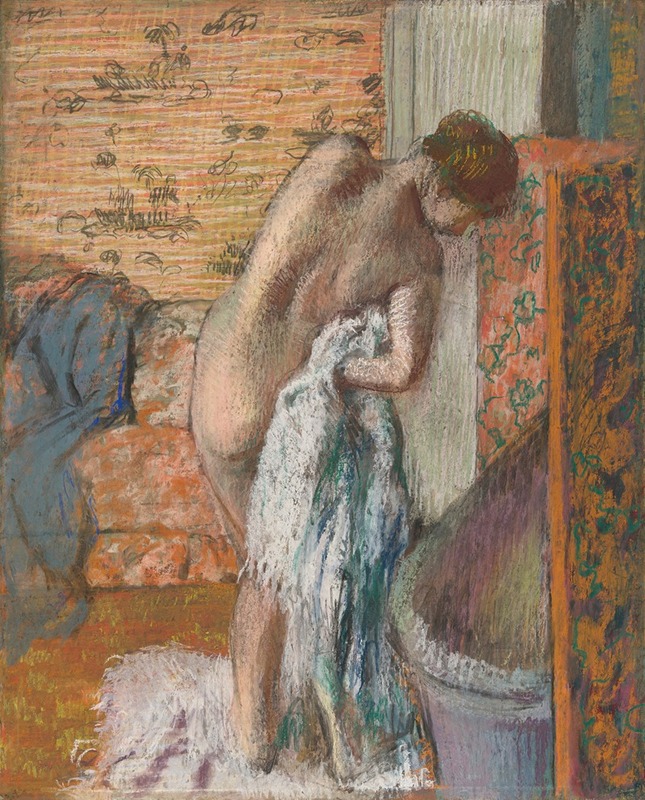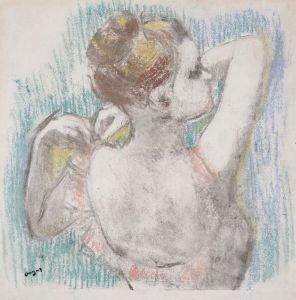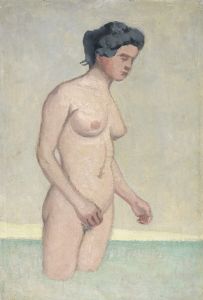
Après le bain
A hand-painted replica of Edgar Degas’s masterpiece Après le bain, meticulously crafted by professional artists to capture the true essence of the original. Each piece is created with museum-quality canvas and rare mineral pigments, carefully painted by experienced artists with delicate brushstrokes and rich, layered colors to perfectly recreate the texture of the original artwork. Unlike machine-printed reproductions, this hand-painted version brings the painting to life, infused with the artist’s emotions and skill in every stroke. Whether for personal collection or home decoration, it instantly elevates the artistic atmosphere of any space.
"Après le bain" (After the Bath) is a recurring theme in the works of Edgar Degas, a prominent French artist known for his contributions to Impressionism, although he preferred to be associated with Realism. Degas was born on July 19, 1834, in Paris, France, and became renowned for his innovative compositions and his focus on the human figure, particularly dancers and women in intimate settings.
The "Après le bain" series consists of several paintings and pastels created by Degas, primarily during the late 19th century. These works typically depict women in various stages of bathing or drying themselves, capturing moments of privacy and introspection. Degas was fascinated by the natural, unguarded movements of the human body, and he sought to portray these in a realistic yet aesthetically pleasing manner.
Degas's approach to the "Après le bain" series reflects his interest in Japanese prints, which influenced many Impressionist artists. The compositions often feature unusual angles and cropping, reminiscent of the ukiyo-e style. This influence is evident in the way Degas captures the spontaneity and fluidity of the figures, emphasizing the grace and elegance of everyday actions.
One of the notable aspects of Degas's work in this series is his use of pastels, a medium he increasingly favored later in his career. Pastels allowed Degas to achieve a soft, velvety texture and a rich interplay of colors, which he used to great effect in rendering the skin tones and the play of light on the bodies of his subjects. The delicate layering of colors in these works contributes to their sense of immediacy and intimacy.
Degas's "Après le bain" works are characterized by their focus on the female form, often depicted in a manner that is both candid and respectful. Unlike some of his contemporaries, Degas's portrayal of women in these private moments avoids overt sensuality, instead highlighting the natural beauty and dignity of the human body. This approach aligns with his broader artistic philosophy, which emphasized observation and the depiction of modern life.
Throughout his career, Degas was known for his meticulous attention to detail and his dedication to capturing the essence of movement. In the "Après le bain" series, this is evident in the careful rendering of the figures' poses and the subtle interplay of light and shadow. The compositions often convey a sense of tranquility and introspection, inviting viewers to contemplate the quiet beauty of everyday moments.
Degas's exploration of the theme of women bathing was part of a broader interest in depicting scenes of modern life, a hallmark of the Impressionist movement. However, his unique approach and technical skill set him apart from his peers, earning him a lasting place in the history of art. Today, works from the "Après le bain" series can be found in major museums and private collections worldwide, continuing to captivate audiences with their timeless beauty and insight into the human experience.


















